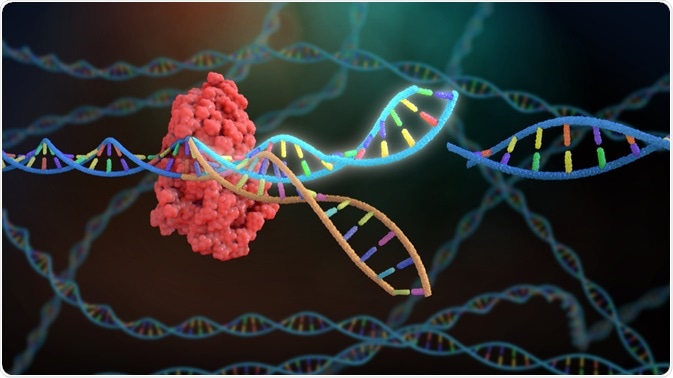CRISPR is a relatively easy scientific technique that has gained a considerable amount of publicity due to its ability to alter the genetic profile of human embryos in order to prevent mutations from being passed onto future generations. More recently, a group of reproductive biologists in New York investigated the ability of CRISPR to alter the DNA of human sperm for this same purpose.
 Image Credit: Nathan Devery / Shutterstock.com
Image Credit: Nathan Devery / Shutterstock.com
What is CRISPR?
CRISPR technology is a powerful gene-editing tool that has allowed scientists to alter, add, and/or remove genetic material at specific locations within the genome. The actual CRISPR technology is known as CRISPR-Cas9, in which the enzyme Cas9 cuts strands of CRISPRs, which are specialized regions of DNA that are comprised of both nucleotide repeats and spacers throughout the strands.
Some of the most recent applications of CRISPR include the removal of defective heart disease tissue from embryos, increasing the resistance of plants to disease, and several controversial human genome-editing projects that have gained a considerable amount of attention.
CRISPR and Human Gene-Editing
In one of the most controversial scientific studies that have been announced in recent history, He Jiankui utilized CRISPR technology to alter the genomes of twin fetuses in an effort to provide them both protection against HIV.
Unfortunately, this capricious action, which has been described as both foolish and irresponsible, has caused many scientists around the world to support a global moratorium on all research that could alter the genetic makeup of human embryos, even if there was no intention for their implantation.
On the other hand, many scientists around the world believe that despite the backlash Jiankui received, his work will actually move countless human gene editing projects forward.
Editing DNA in Human Sperm
Scientists at Weill Cornell Medicine in New York City have recently applied CRISPR technology to human sperm. Originally the researchers were interested in eliminating genetic mutations that cause male infertility; however, recent work by this team has moved beyond male infertility to a wide range of other genetic mutations of the man from being passed onto the embryo during fertilization.
More specifically, the reproductive biologist team targeted BRCA2, which is a well-known gene associated with increasing the individual’s risk of acquiring breast, ovarian, prostate, and several other types of cancers.
The methodology behind Cornell’s experiment begins with frozen sperm samples that are thawed and analyzed under the microscope to confirm their viability. After examining the specimen, the researchers perform electroporation, which is a process that allows microscope CRISPR technology to be delivered into the tightly-wound head of each sperm cell.
During electroporation, a 1,100-volt shock is delivered to the sperm specimen, thereby allowing the sperm cells to loosen up and become more available for CRISPR entry. The Cornell team has been dedicated to optimizing their electroporation protocol in order to ensure that there is a balance of the electric shock that both allows the CRISPR reagents to enter the cell without compromising the integrity of the sperm.
Following electroporation, the sperm sample is placed into a solution containing the CRISPR tool that has been uniquely designed for BRCA2 targeting. Although the altered sperm created by this team has not yet been applied to human embryos, their findings demonstrate a promising future in the field of human gene editing.
Further Reading